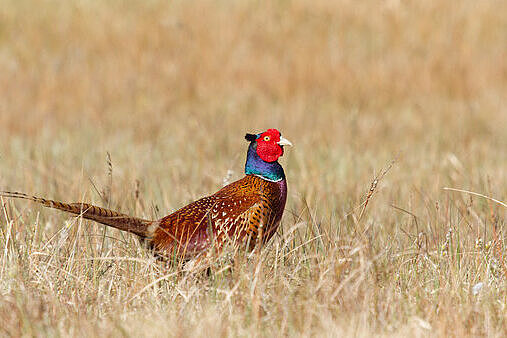Chicken meat

Chicken meat is a popular ingredient in many dog food products and is also suitable as a treat or supplementary food. But what exactly is chicken meat and how healthy is it for your dog? In this article, you'll find out everything you need to know about chicken meat for dogs and its advantages and disadvantages.
What is chicken meat?
Chicken meat is the meat of domestic chickens bred for human and animal consumption. It is a type of poultry meat and is available in various cuts such as breast, thigh, wing or offal. Chicken meat is usually light in color, lean and mild in taste.
What are the benefits of chicken meat for dogs?
Chicken meat has several benefits for dogs that make it a good source of protein. Here are some of them:
- Chicken meat is rich in protein, which is important for muscle building, cell regeneration and the immune system. Protein is made up of amino acids, some of which dogs cannot produce themselves and therefore have to get from their food.
- Chicken meat also contains many vitamins and minerals that are important for a dog's health. These include, for example, vitamin A, B vitamins, iron, zinc and selenium. These nutrients support your dog's eyesight, blood formation, skin and coat health and thyroid function, among other things.
- Chicken meat is easy to digest and is therefore suitable for dogs with sensitive stomachs or low food intake. It can also help to meet your dog's fluid requirements as it contains a lot of water.
- Chicken meat is usually cheap and readily available. You can give it to your dog raw or cooked, or buy it as an ingredient in dry or wet food.
What are the disadvantages of chicken meat for dogs?
Chicken meat also has some disadvantages for dogs. Here are some of them:
- Chicken meat can cause allergies or intolerances in some dogs. This manifests itself, for example, in itching, skin rashes, diarrhea or vomiting. If you suspect that your dog is allergic to chicken meat, you should consult a vet and change their food.
- Chicken meat can also contain salmonella or other bacteria that can be dangerous for your dog. This is especially true of raw chicken, which you should always wash thoroughly and store in a cool place. You should also pay attention to hygiene when handling raw chicken meat and clean your hands and all utensils thoroughly.
- Chicken meat can also be too unbalanced if it is the only food you give your dog. Your dog needs a balanced diet with different types of meat and plant-based ingredients such as vegetables or fruit. You should also make sure that your dog doesn't get too much fat or bones, as this can lead to obesity or injuries.
What should I consider when buying chicken meat for my dog?
- Pay attention to the quality of the meat. The meat should be fresh and clean, without unpleasant odors or discoloration. It should also not contain any bones or cartilage that could harm your dog. If you are not sure whether the meat is still good, you should leave it out or ask for the best-before date.
- Choose the right cut. There are different cuts of chicken that you can feed your dog, e.g. breast, thigh or wing. Breast is usually leaner and lower in fat than the other parts and is suitable for dogs that are overweight or have digestive problems. Thighs and wings are somewhat fattier and juicier and are suitable for dogs with increased energy requirements or dry skin. Different cuts of meat can also be mixed for a balanced diet.
- Cook the meat properly. Chicken should always be well cooked before you give it to your dog. Raw or undercooked chicken can contain bacteria such as salmonella or campylobacter, which can cause serious gastrointestinal infections. You can cook the meat in a pot of water until it is soft and tender. You can also add some vegetables such as carrots or peas to improve the flavor and nutritional value. However, avoid onions, garlic and spices, which can be toxic to dogs.
- Cut the meat into small pieces. The chicken should be cut into bite-sized pieces to make it easier for your dog to chew and swallow. You can also mash or puree the meat with a fork if your dog has difficulty chewing. Make sure there are no sharp edges or splinters that could injure your dog's esophagus or stomach.
- Mix the meat with other ingredients. Chicken meat alone is not enough to provide your dog with optimal nutrition. You should always combine it with other ingredients that provide carbohydrates, fats, vitamins and minerals. A simple and tasty option is to mix the meat with cooked rice and yogurt or pumpkin. You can also mix dry or wet food with the meat to round off the meal.
Difference: Fresh chicken meat and dried chicken meat
Fresh chicken meat consists of around 70 % water and 20 % protein. When it is processed into animal feed, it loses a large proportion of its water content through heating and shrinks accordingly. This means that the actual protein content in the feed is much lower than it appears at first glance. To compensate for this loss, dried chicken meat is often added, which only contains around 10 percent water and consists of 65 percent protein. That sounds good at first, because more protein is better for the dog, isn't it?
Unfortunately, not always. This is because dried chicken meat is not only more concentrated, but also more processed than fresh chicken meat. It is often treated with high temperatures and chemical additives to preserve it and kill germs. In the process, many valuable nutrients are lost and undesirable substances can be produced that can be harmful to the dog. For example, dried chicken meat can contain high levels of nitrites, which can form carcinogenic nitrosamines when combined with other substances. Dried chicken meat can also contain too much protein, which puts a strain on the dog's metabolism and can lead to kidney problems.
So how can you tell whether your dog's food contains fresh or dried chicken? A simple trick is to pay attention to the order of the ingredients. The ingredients in the food are sorted by weight, with the heaviest ones listed first. So if fresh chicken meat is listed first, it doesn't necessarily mean that it makes up the largest proportion of the food. It may be that after drying it weighs much less than other ingredients that are further down the list. However, if dried chicken comes first, you can be sure that it contains a lot of protein and may be too much for your dog.
The best choice for your dog is a food that contains a balance of fresh and dried chicken or no dried chicken at all. Also pay attention to other quality features such as the origin of the meat, the use of natural preservatives and the exact percentage of meat in the food.
What is hydrolyzed chicken meat?
Hydrolyzed chicken meat is chicken meat that has been broken down into smaller components through a chemical process called hydrolysis. Enzymes are used to break down the protein molecules of the chicken meat into smaller peptide chains. These peptide chains are so small that they are no longer recognized as foreign or threatening by the dog's immune system.
Why is hydrolyzed chicken meat used in dog food? The main reason is that some dogs suffer from food allergies triggered by certain proteins. Chicken is a common source of protein in dog food and can cause allergic reactions such as itching, skin rash, diarrhea or vomiting in some dogs. When these dogs eat hydrolyzed chicken meat, these symptoms are eliminated because the immune system no longer recognizes the protein as an allergen.
Hydrolyzed chicken is often used in special diets prescribed by a veterinarian. These diets are often suitable for dogs with severe food allergies, inflammatory bowel disease or sensitive stomachs. Hydrolyzed chicken can also be used as part of an elimination diet to determine if the dog is allergic to other proteins.
What are the pros and cons of hydrolyzed chicken in dog food? One benefit of hydrolyzed chicken is that it is a safe and effective way to relieve the symptoms of allergic dogs. It can improve the dog's quality of life and well-being and help them lead a normal and healthy life.
One disadvantage of hydrolyzed chicken is that it is often more expensive than regular dog food and is only available on prescription. In addition, the dog may not like or tolerate the food because it tastes or smells different to what he is used to. Some manufacturers also use flavor enhancers or other additives to make the food more palatable, which in turn can lead to intolerances.
Another disadvantage of hydrolyzed chicken meat is that it is not a long-term solution to a food allergy. It only treats the symptoms and not the cause of the allergy. In addition, the dog may develop a sensitivity to the hydrolyzed protein over time and become allergic again. Therefore, it is important to talk to your vet and get individualized nutritional advice for your dog.
Chicken is a good ingredient for your dog's food as long as he can tolerate it and you feed it in moderation. It provides him with plenty of protein and other important nutrients and is easy to digest. However, you should pay attention to the quality and hygiene of the meat.
Properties 13
Are you looking for other ingredients with a specific property?
Just click on them to find more.
If you notice any signs of hypersensitivity or poisoning in your dog, you should see your vet immediately. We are not a substitute for a vet, but we try to be as accurate as possible. Every dog reacts differently and we recommend you get a second opinion or consult your vet if in doubt.
Stay healthy and take good care of your four-legged friend!😊
Similar to Chicken meat
Duck meat is the muscle meat of domestic and wild ducks. It is a type of poultry meat and has a high protein content. It also contains many important nutrients such as iron, zinc, selenium and B...
Pheasant meat is the meat of pheasants, a bird species that originally comes from Asia and was introduced to Europe as game for hunting. Pheasants belong to the chicken family and have dark, lean...
Chicken stomachs are part of the chicken's digestive system. They are used to break down and pre-digest the food. Chicken stomachs consist of muscle meat and have a firm and chewy consistency. They...
Chicken protein is a collective term for various proteins that are obtained from chicken meat, offal or feathers. Proteins are important building blocks for your dog's body and fulfill many...



